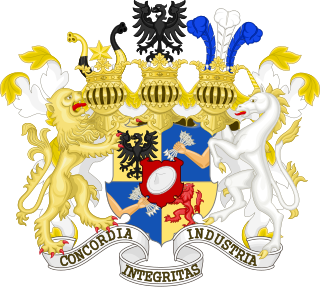
The Rothschild family is a wealthy Ashkenazi Jewish noble banking family originally from Frankfurt. The family's documented history starts in 16th century Frankfurt; its name is derived from the family house, Rothschild, built by Isaak Elchanan Bacharach in Frankfurt in 1567. The family rose to prominence with Mayer Amschel Rothschild (1744–1812), a court factor to the German Landgraves of Hesse-Kassel in the Free City of Frankfurt, Holy Roman Empire, who established his banking business in the 1760s. Unlike most previous court factors, Rothschild managed to bequeath his wealth and established an international banking family through his five sons, who established businesses in Paris, Frankfurt, London, Vienna, and Naples. The family was elevated to noble rank in the Holy Roman Empire and the United Kingdom.

The Creditanstalt, full original name k. k. priv. Österreichische Credit-Anstalt für Handel und Gewerbe, was a major Austrian bank, founded in 1855 in Vienna.

HypoVereinsbank (HVB), legally registered since late 2008 as UniCredit Bank GmbH, is a significant bank in Germany headquartered in Munich. It has been part of the Milan-based UniCredit group since 2005, and fully owned by it since 2008. As a consequence, HVB is operating exclusively in Germany, where it mainly focuses on private clients business and corporate banking, customer-related capital market activities and wealth management.

UniCredit S.p.A. is an international banking group headquartered in Milan. It is a systemically important bank and the world's 34th largest by assets. It was formed through the merger of Credito Italiano and Unicredito in 1998 but has a corporate identity stretching back to its first foundation in 1870 as Banca di Genova. UniCredit is listed on the Borsa Italiana and Frankfurt Stock Exchange and is a constituent stock of the Euro Stoxx 50 index of leading shares.

UniCredit Bank Austria AG, branded and widely referred to as Bank Austria, is an Austrian bank, 99,9965% owned by Milan-based pan-European banking group UniCredit. Bank Austria was formed in 1991 by merger of Vienna's Länderbank and Zentralsparkasse, acquired Creditanstalt-Bankverein in 1997, and merged with it to form Bank Austria-Creditanstalt (BA-CA) in 2002. Its name reverted to Bank Austria in 2008, as UniCredit, the bank's owner since 2005, phased out the history-laden Creditanstalt brand.

The Rothschild banking family of Austria was the Austrian branch of the Rothschild family. It was founded in 1820 by Salomon Mayer von Rothschild in Vienna, which was then part of the Austrian Empire.
Bethmann Bank AG is a German private bank headquartered in Frankfurt am Main. It is a subsidiary of the Dutch ABN AMRO Bank N.V. and was the product of a merger between the historical German banks Delbrück, Bethmann and Maffei under the umbrella of the renowned Dutch ABN AMRO Bank. LGT Bank Deutschland joined this group in 2011. Bethmann Bank acquired the German private banking activities of Credit Suisse in December 2013. The acquisition positions Bethmann Bank, ABN AMRO's private bank in Germany, as the third largest private bank in Germany.

The Bayerische Vereinsbank was a German bank founded in 1869 in Munich. It developed into one of the largest regional banks in Germany, before merging in 1998 with Bayerische Hypotheken- und Wechsel-Bank to form HypoVereinsbank (HVB).

UniCredit Bulbank is the largest bank of Bulgaria. Before 1994, the bank was known as the Bulgarian Foreign Trade Bank or BFTB. UniCredit Bulbank was formed in 2007 as a merger between Bulbank, Biochim, and Hebros Bank, all of them owned by the UniCredit Group.

The Disconto-Gesellschaft was a significant German bank, founded in Berlin in 1851. It was one of the largest German banking organizations until its 1929 merger into Deutsche Bank.
The Norisbank is a German bank with headquarters in Bonn. Since 2 November 2006, it has been a subsidiary of Deutsche Bank and since 27 July 2012 purely a direct bank.

The Anglo-Österreichische Bank, in shorthand Anglobank, was a bank founded in Vienna in 1863 with an extensive branch network in the Habsburg Monarchy and later in its successor states, primarily Austria and Czechoslovakia.

The Länderbank, full original name k. k. privilegierte Österreichische Länderbank, was a major Austrian bank, created in 1880. In 1922 its head office was moved to Paris under the name Banque des Pays de l'Europe Centrale, even though its activity remained overwhelmingly in the Austrian operations. After the 1938 Anschluss the latter came under control of Dresdner Bank by the name Länderbank Wien. It was nationalized in 1946, renamed Österreichische Länderbank AG in 1948, and eventually merged in 1991 with Vienna's Zentralsparkasse to form Bank Austria, which in turn has been a subsidiary of UniCredit since 2005.

The Austro-Hungarian Bank was the central bank of the Habsburg Monarchy in the 19th and early 20th centuries.

The Bayerische Hypotheken- und Wechsel-Bank was a German bank founded in 1834 in Munich. It developed into one of the largest regional banks in Germany, before merging in 1998 with Bayerische Vereinsbank to form HypoVereinsbank (HVB).

The Schoeller family is a German noble family. Originally from the Rhineland, the family had extensive business holdings throughout Europe for many a generation.

Sir Paul Eduard von Schoeller was an Austrian mining industrialist.

Richard Ritter von Schoeller was an Austrian banker and industrialist in the mining industry.

Wilhelm Alexander Ritter von Schoeller, was a German-Austrian industrialist, entrepreneur and banker.

Philipp Wilhelm von Schoeller, was a German-Austrian entrepreneur and banker as well as an art photographer.



















